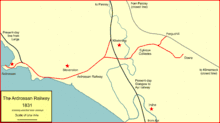Ardrossan Railway
| Ardrossan Railway | |||||||||||||||||||||||||||||||||||||||||||||||||||||||||||||||||||||||||||||||||||||||||||||||||||||||||||||||||||||||||||||||||||||||||||||
|---|---|---|---|---|---|---|---|---|---|---|---|---|---|---|---|---|---|---|---|---|---|---|---|---|---|---|---|---|---|---|---|---|---|---|---|---|---|---|---|---|---|---|---|---|---|---|---|---|---|---|---|---|---|---|---|---|---|---|---|---|---|---|---|---|---|---|---|---|---|---|---|---|---|---|---|---|---|---|---|---|---|---|---|---|---|---|---|---|---|---|---|---|---|---|---|---|---|---|---|---|---|---|---|---|---|---|---|---|---|---|---|---|---|---|---|---|---|---|---|---|---|---|---|---|---|---|---|---|---|---|---|---|---|---|---|---|---|---|---|---|---|
| |||||||||||||||||||||||||||||||||||||||||||||||||||||||||||||||||||||||||||||||||||||||||||||||||||||||||||||||||||||||||||||||||||||||||||||
| |||||||||||||||||||||||||||||||||||||||||||||||||||||||||||||||||||||||||||||||||||||||||||||||||||||||||||||||||||||||||||||||||||||||||||||
The Ardrossan Railway was a railway company in Scotland built in the mid-19th century that primarily ran services between Kilwinning and Ardrossan, as well as freight services to and from collieries between Kilwinning and Perceton. The line was later merged with the Glasgow and South Western Railway, and is today part of the Ayrshire Coast Line.
History

In the first years of the nineteenth century, the 12th Earl of Eglinton developed Ardrossan Harbour, intending it as a sea port for the City of Glasgow. The extensive works he had carried out cost over £100,000. At that time the River Clyde was not navigable to large vessels, and he proposed a canal to reach Ardrossan. In 1806 he obtained Parliamentary authority to construct the Glasgow, Paisley and Ardrossan Canal. The authorised share capital was £140,000, but subscriptions disappointed him, amounting to only £44,342. Work proceeded from the Glasgow end, but the canal only reached Johnstone, all of the available money having been expended and debts of £71,209 incurred.
The truncated canal traded for some years, but in the 1820s the idea was proposed to build a railway to close the gap. An Act for the Ardrossan and Johnstone Railway was obtained on 14 June 1827, the estimate for the work being £94,093; the debt of the canal enterprise was not assumed by the new railway company.
Once again subscriptions fell short of the desired value: they amounted to only £28,950, but work started, from the Ardrossan end, and once again the money was entirely expended, this time with debts of £20,000, after only part of the scheme was built. It reached only from Ardrossan to Kilwinning, but with a long eastward branch that served collieries—most of them part of Eglinton's estate. By now the Clyde had been deepened and sea-going vessels could reach Glasgow. In comparison, even had the railway been completed, it would have required transshipment twice (from ship to railway and from railway to canal), and it was clear that shipping owners would find that unattractive. It is likely that the emphasis had shifted from making the Glasgow connection.
The line opened in 1831; it was horse-operated and the track gauge 4 ft 6 in (1,372 mm) (later sometimes referred to as the Scotch gauge).[1] For passenger services, a carriage held 24 passengers; 16 inside and 8 outside.[2][3]
The rail was of the fish-bellied type, weighing 28 lbs/yd, supported at a pitch of 3 feet on small freestone blocks. The principal goods traffic was coal from the collieries served; Whishaw says that "The amount of coals from the Eglinton coal-field is stated to be about 80,000 tons per annum; and the average number of passengers, for the three years ending September 1839, about 31,000 annually. There are about 440 wagons in use on this line, which belong to the coal-proprietors." That is, the line provided the track for hauliers to use, for a toll.
He goes on, "The carriages hitherto used on this line were drawn by horses; each carriage holding twenty-four passengers, viz. sixteen inside and eight outside ... The outside seats are on the same level as those within; the one being in front, the other behind. ... Previously to November 1838, the passenger's fare was set at the rate of one penny per mile; but was raised in consequence of the Government duty to 8d. per six miles, or 1.333d. per mile." About a hundred passengers a day is a remarkable number for a line with a limited network.[4]
The main line of the railway ran to a terminal west of the contemporary location of Kilwinning town centre, as part of the putative route to Johnstone. The long branch ran east from near the site of the later Dubbs Junction, crossing the path of the later Kilwinning - Irvine route, forking to reach Fergus Hill where there was a colliery, and a pit at Doura.[3][3][4][4]
Locomotive operation
In 1840 the line was regauged to standard gauge and connected with the Glasgow, Paisley, Kilmarnock and Ayr Railway at Kilwinning station. The permanent way was largely relaid with heavier equipment to accommodate locomotive operation, and the line was doubled. In 1854 both lines merged with the new Glasgow and South Western Railway.
Connections to other lines
- Glasgow, Paisley, Kilmarnock and Ayr Railway at Kilwinning
Current operations
The majority of this line is still in use as part of the Largs branch, carrying passenger services marketed as the Ayrshire Coast Line. The Doura branch from Dubbs closed, and the short section at Ardrossan which later served Ardrossan Winton Pier railway station was shortened to Ardrossan Harbour railway station).
References
- ↑ David Ross, The Glasgow and South Western Railway: A History, Stenlake Publishing Limited, Catrine, 2104, ISBN 978 1 84033 648 1
- ↑ C J A Robertson, The Origins of the Scottish Railway System, 1722 - 1844, John Donald Publishers Ltd, Edinburgh, 1983, ISBN 0-85976-088-X
- 1 2 3 Lewin, pages 17 - 18
- 1 2 3 Whishaw
Further reading
- Butt, R. V. J. (1995). The Directory of Railway Stations: details every public and private passenger station, halt, platform and stopping place, past and present (1st ed.). Sparkford: Patrick Stephens Ltd. ISBN 978-1-85260-508-7. OCLC 60251199.
- Lewin, Henry Grote (1925). Early British Railways. A short history of their origin & development 1801-1844. London: The Locomotive Publishing Co Ltd. OCLC 11064369.
- Stansfield, G. (1999). Ayrshire & Renfrewshire's Lost Railways. Ochiltree: Stenlake Publishing. ISBN 1-8403-3077-5.
- Whishaw, Francis (1842). The Railways of Great Britain and Ireland Practically Described and Illustrated (2nd ed.). London: John Weale. pp. 6–10. OCLC 833076248.